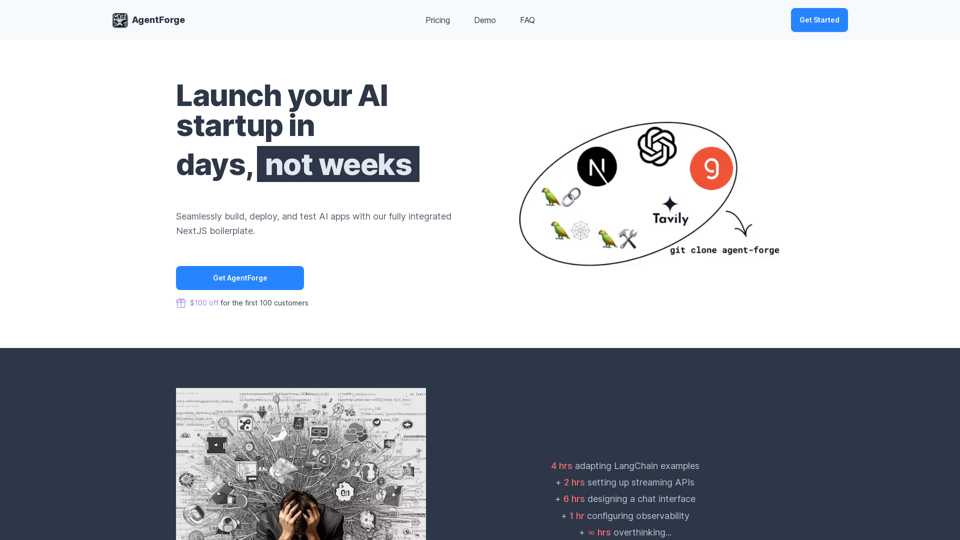PandasAI is an open-source AI-powered platform that revolutionizes enterprise data analysis. It allows users to interact with their data using natural language, providing real-time insights and actionable information. This innovative tool seamlessly integrates with various data sources, offers enhanced analytics, and creates visual representations of data, making it an invaluable asset for data-driven decision-making across organizations.
PandasAI - Conversational Data Analysis
PandasAI is a Python library that integrates generative artificial intelligence capabilities into pandas, making dataframes conversational.
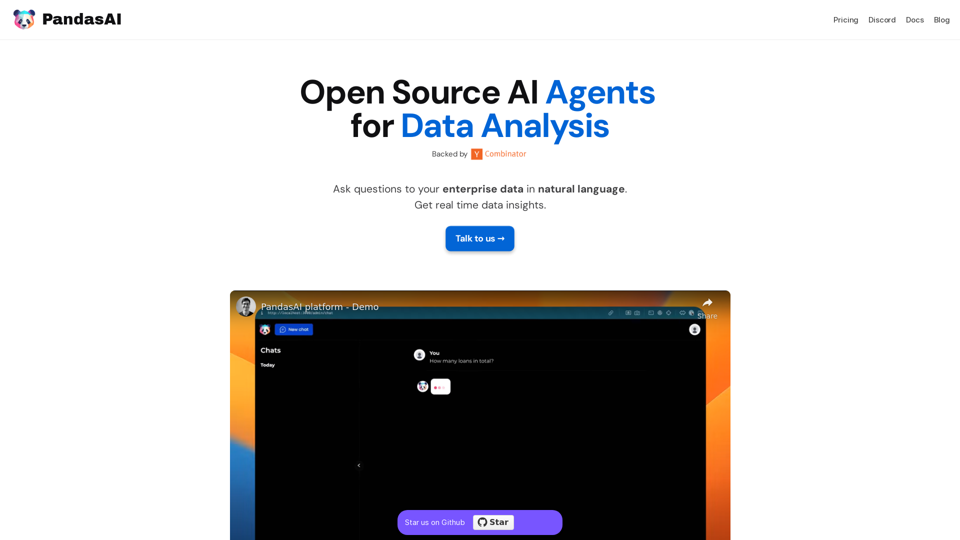
Introduction
Feature
Open Source and Accessible
PandasAI is an open-source library, democratizing data analysis and making it accessible to a wide range of users. This feature promotes transparency and community-driven improvements.
Seamless Data Integration
The platform easily connects to multiple data sources, including:
- SQL databases
- NoSQL databases
- CSV files
- Excel spreadsheets (xls)
This versatility ensures smooth integration with existing data infrastructure.
Natural Language Processing
Users can interact with their data using natural language queries, simplifying the data analysis process and making it more intuitive.
Enhanced Analytics
PandasAI provides comprehensive analytics by:
- Combining data from multiple sources
- Transforming raw data into actionable insights
- Enabling data-driven strategy implementation
Visual Data Representation
The platform creates intuitive charts and visualizations, making it easier to:
- Interpret complex business data
- Identify trends and patterns
- Communicate insights effectively
Real-time Insights
PandasAI delivers instant data insights, allowing users to make timely decisions based on the most current information available.
Detailed Reporting
Generate comprehensive reports to:
- Keep teams aligned and informed
- Track progress and performance
- Support data-driven decision-making processes
FAQ
Is PandasAI suitable for users without technical expertise?
Yes, PandasAI is designed to be user-friendly. Its natural language processing capabilities allow users to ask questions in plain language, making it accessible to both technical and non-technical users.
How does PandasAI handle data security and privacy?
As an open-source platform, PandasAI's code is transparent and can be audited for security. However, users should implement appropriate security measures when integrating it with their data infrastructure to ensure data privacy and protection.
Can PandasAI handle large volumes of data?
PandasAI is built to work with various data sources and can handle large datasets. However, the performance may depend on the underlying hardware and infrastructure. It's recommended to test with your specific data volume to ensure optimal performance.
Is there a community or support system for PandasAI users?
Yes, PandasAI has a community on Discord where users can seek support, share experiences, and contribute to the platform's development. Additionally, users can reach out through the official website for more formal support options.
Latest Traffic Insights
Monthly Visits
44.27 K
Bounce Rate
39.36%
Pages Per Visit
1.79
Time on Site(s)
15.63
Global Rank
717361
Country Rank
Russia 130084
Recent Visits
Traffic Sources
- Social Media:3.76%
- Paid Referrals:0.72%
- Email:0.15%
- Referrals:10.78%
- Search Engines:50.98%
- Direct:33.40%
Related Websites
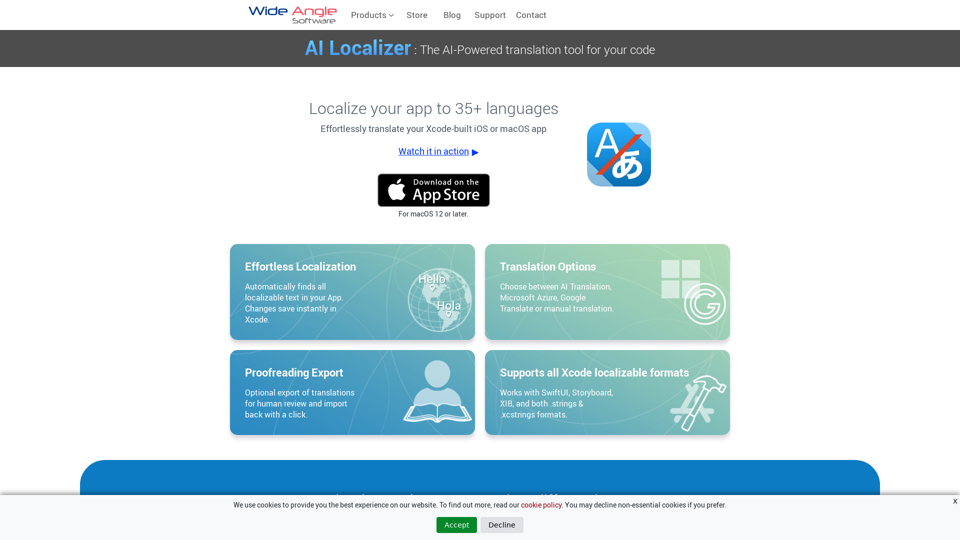
Seamlessly add localized translations to your Xcode projects. Add up to 37 languages to your app automatically, using the power of AI.
210.21 K
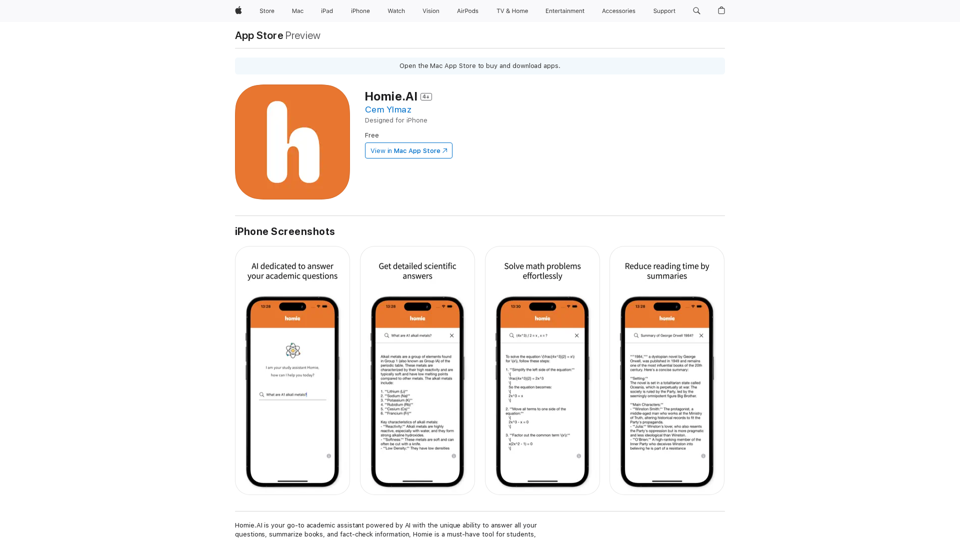
Homie.AI is your go-to academic assistant powered by AI with the unique ability to answer all your questions, summarize books, and fact-check information, Homie is always here to help you with your academic needs.
124.77 M
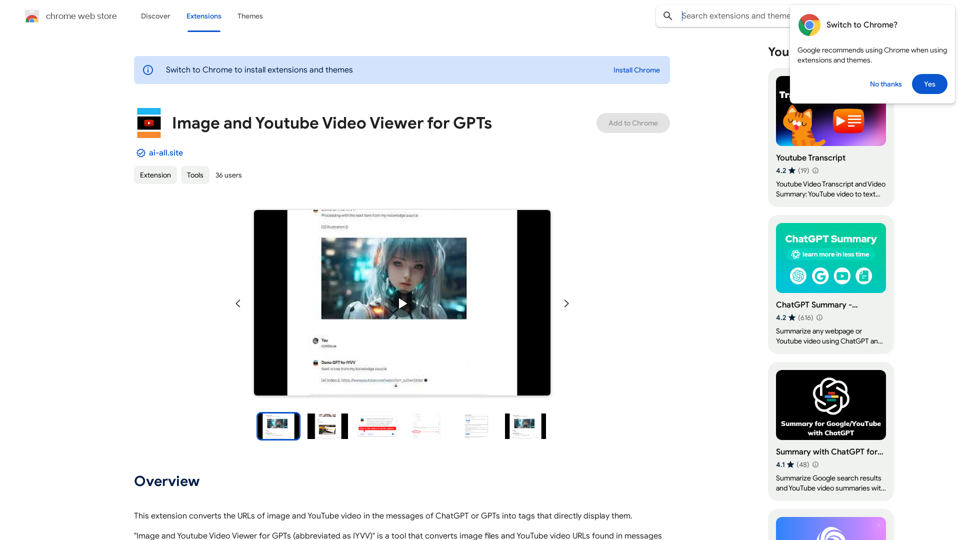
This extension changes the links for images and YouTube videos in ChatGPT or GPT messages into tags that show the images and videos directly.
193.90 M
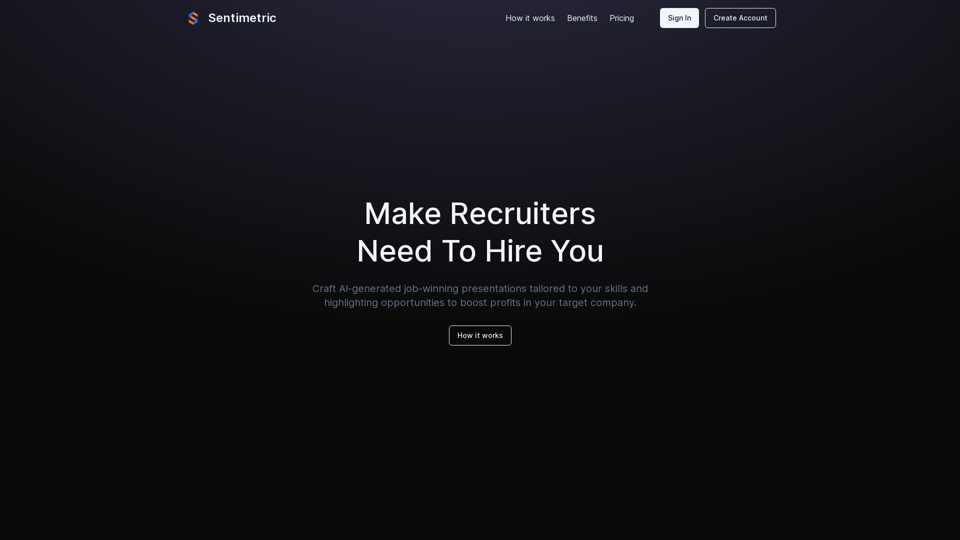
Sentimetric Sentimetric is a method used to measure the sentiment of text data, such as customer reviews, comments, or social media posts. It involves analyzing the emotional tone or attitude conveyed by the text, whether it's positive, negative, or neutral.
Sentimetric Sentimetric is a method used to measure the sentiment of text data, such as customer reviews, comments, or social media posts. It involves analyzing the emotional tone or attitude conveyed by the text, whether it's positive, negative, or neutral.Unlock your career potential with our AI-powered job application presentation builder designed to help you stand out in the competitive job market. Our app goes beyond traditional cover letters and resumes by creating personalized presentations that show recruiters how your skills and experience align with company goals and values. Plus, we provide project ideas with SWOT analyses that will impress every recruiter.
0
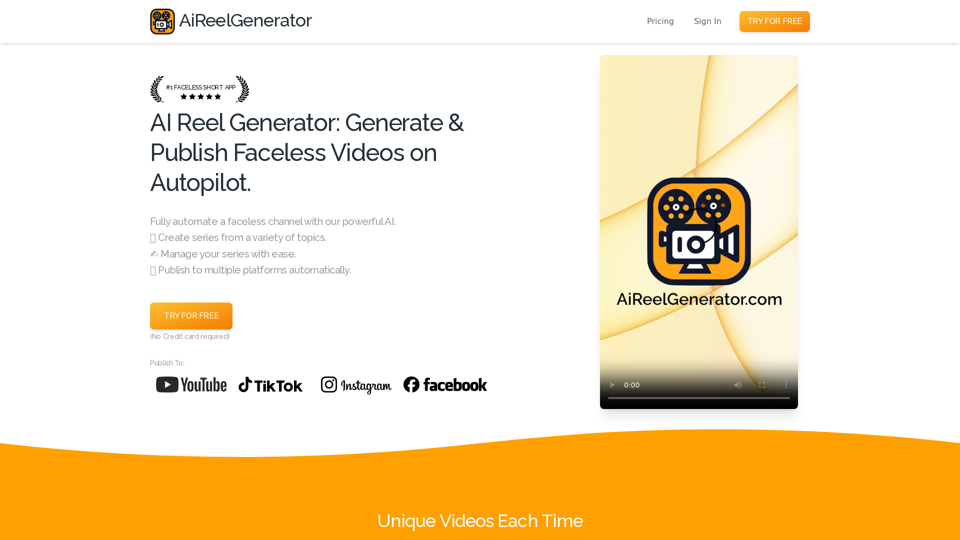
AiReelGenerator.com | Faceless Videos on Autopilot.
AiReelGenerator.com | Faceless Videos on Autopilot.Discover AiReelGenerator, the newest app that automatically makes videos without faces. Just pick a subject, and our AI will make and upload fresh videos to your YouTube, TikTok, Instagram, or Facebook account every day.
196
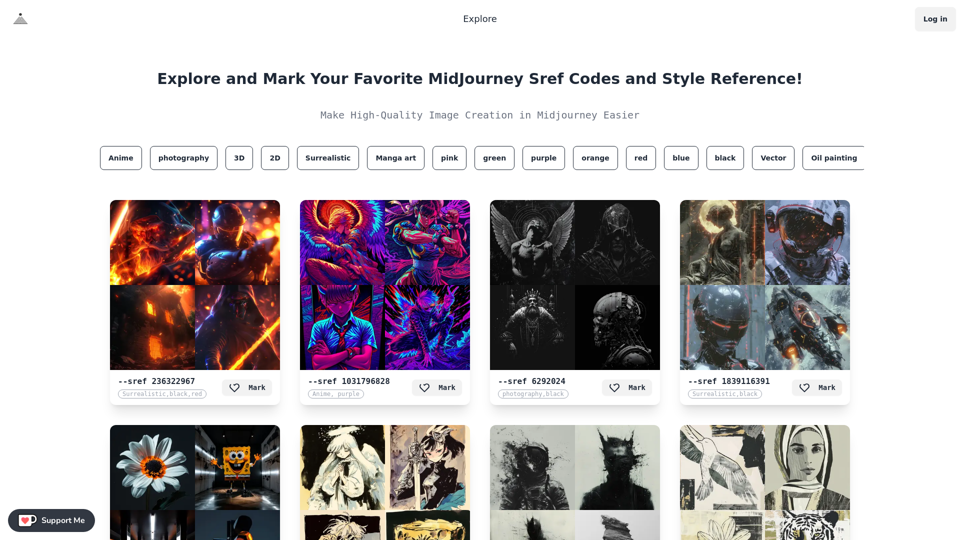
Midjourney SREF Codes Library for Style Reference What are SREF Codes? SREF codes are special text strings used in Midjourney to quickly and easily apply specific artistic styles to your image generations. How to Use SREF Codes: Simply add an SREF code to your Midjourney prompt. For example: `/imagine a majestic dragon, SREF:cyberpunk` SREF Code Library: This library contains a collection of SREF codes categorized by style. * Art Styles: * `photorealistic`: Creates images with high levels of realism. * `impressionistic`: Captures the essence of a scene with loose brushstrokes and vibrant colors. * `cubist`: Breaks down objects into geometric shapes. * `surrealist`: Creates dreamlike and fantastical images. * `abstract`: Focuses on form, color, and composition rather than representational imagery. * Visual Effects: * `cinematic`: Gives images a cinematic look and feel. * `HDR`: Creates images with high dynamic range, resulting in greater detail and contrast. * `neon`: Adds vibrant neon lights to the image. * `pixel art`: Generates images in a retro pixel art style. * Other Styles: * `anime`: Creates images in the style of Japanese animation. * `manga`: Similar to anime, but with a more comic book aesthetic. * `sketch`: Generates images that resemble pencil sketches. * `watercolor`: Creates images with the look and feel of watercolor paintings. Note: This is just a small sample of the many SREF codes available. Explore and Experiment: The best way to learn about SREF codes is to experiment with them! Try combining different codes to create unique and interesting styles.
Midjourney SREF Codes Library for Style Reference What are SREF Codes? SREF codes are special text strings used in Midjourney to quickly and easily apply specific artistic styles to your image generations. How to Use SREF Codes: Simply add an SREF code to your Midjourney prompt. For example: `/imagine a majestic dragon, SREF:cyberpunk` SREF Code Library: This library contains a collection of SREF codes categorized by style. * Art Styles: * `photorealistic`: Creates images with high levels of realism. * `impressionistic`: Captures the essence of a scene with loose brushstrokes and vibrant colors. * `cubist`: Breaks down objects into geometric shapes. * `surrealist`: Creates dreamlike and fantastical images. * `abstract`: Focuses on form, color, and composition rather than representational imagery. * Visual Effects: * `cinematic`: Gives images a cinematic look and feel. * `HDR`: Creates images with high dynamic range, resulting in greater detail and contrast. * `neon`: Adds vibrant neon lights to the image. * `pixel art`: Generates images in a retro pixel art style. * Other Styles: * `anime`: Creates images in the style of Japanese animation. * `manga`: Similar to anime, but with a more comic book aesthetic. * `sketch`: Generates images that resemble pencil sketches. * `watercolor`: Creates images with the look and feel of watercolor paintings. Note: This is just a small sample of the many SREF codes available. Explore and Experiment: The best way to learn about SREF codes is to experiment with them! Try combining different codes to create unique and interesting styles.Explore a list of 177 unique Midjourney sref codes and style references to find your perfect Midjourney sref code effect.
149.96 K
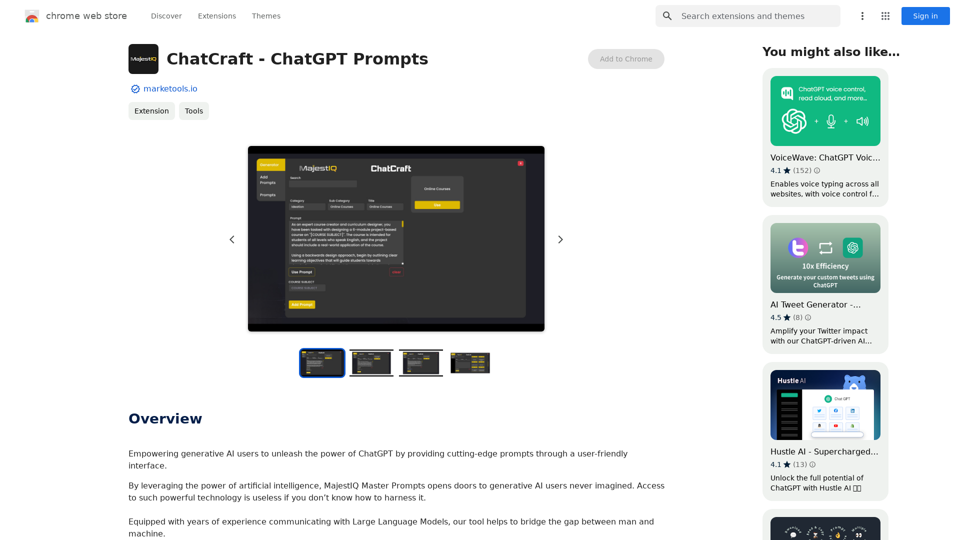
ChatCraft - ChatGPT Prompts What is ChatCraft? ChatCraft is a tool that helps you generate creative and effective prompts for ChatGPT. Why Use ChatCraft? * Unlock ChatGPT's Potential: Get more insightful, engaging, and surprising responses from ChatGPT. * Save Time and Effort: Quickly brainstorm and refine prompts without getting stuck. * Explore New Ideas: Discover unique angles and perspectives for your ChatGPT interactions. How to Use ChatCraft: 1. Choose a Category: Select from a range of categories like storytelling, code generation, dialogue writing, and more. 2. Provide Input: Give ChatCraft some context or keywords related to your desired outcome. 3. Generate Prompts: ChatCraft will generate a variety of tailored prompts for you to use with ChatGPT. 4. Experiment and Refine: Try out different prompts and see what works best for your needs. Let ChatCraft be your guide to unlocking the full potential of ChatGPT!
ChatCraft - ChatGPT Prompts What is ChatCraft? ChatCraft is a tool that helps you generate creative and effective prompts for ChatGPT. Why Use ChatCraft? * Unlock ChatGPT's Potential: Get more insightful, engaging, and surprising responses from ChatGPT. * Save Time and Effort: Quickly brainstorm and refine prompts without getting stuck. * Explore New Ideas: Discover unique angles and perspectives for your ChatGPT interactions. How to Use ChatCraft: 1. Choose a Category: Select from a range of categories like storytelling, code generation, dialogue writing, and more. 2. Provide Input: Give ChatCraft some context or keywords related to your desired outcome. 3. Generate Prompts: ChatCraft will generate a variety of tailored prompts for you to use with ChatGPT. 4. Experiment and Refine: Try out different prompts and see what works best for your needs. Let ChatCraft be your guide to unlocking the full potential of ChatGPT!Helping users of generative AI get the most out of ChatGPT by giving them easy-to-use, advanced prompts.
193.90 M
